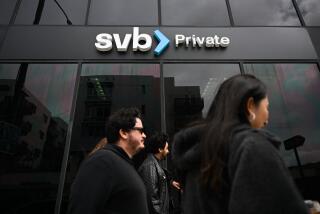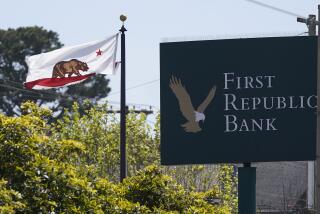Bank Board Doubles S&L; Bailout Costs : Sees Aid for Texas Institutions in 1990s Reaching $15 Billion
- Share via
WASHINGTON — In a revelation that stunned the House Banking Committee, the Federal Home Loan Bank Board said Thursday that the potential cost over the next decade of rescuing failing savings and loans in Texas, where a sagging economy has battered the industry, has more than doubled to $15.2 billion.
The bank board said that increasingly gloomy prospects for the S&L; industry in Texas have pushed up its estimate of the nationwide cost of bailing out the savings industry to a total of $30.9 billion. In May, the bank board had pegged the nationwide cost at $22.7 billion.
Cites Past Assurances
Rep. Stan Parris (R-Va.), a member of the House Banking Committee, complained that M. Danny Wall, the bank board chairman, had assured members of Congress just last week that $7 billion would be adequate to close or merge failing S&Ls; in Texas. But “now the number has magically escalated to $15 billion,” Parris said. “The rosy scenario changes so fast I can’t identify it.”
Wall said the new figures, based on a computer run completed at 6:32 a.m. Thursday, represented a more “realistic assessment” of the expenses of finding merger partners for ailing institutions or shutting them down.
Either way, the government is stuck with the bad loans. And, when it closes an institution, it must make good on deposits of up to $100,000, which are federally insured.
In a suggestion that the nationwide cost of rescuing failing S&Ls; could go still higher, Wall also announced that the federal S&L; insurance fund would have substantially more resources available than previously planned for that purpose.
Wall said that a special assessment on healthy S&Ls; will be extended for three more years to raise additional funds to cope with the crisis. The fee is one-eighth of 1% of insured deposits.
The extension is sure to add fuel to the industry’s growing frustration over its annual insurance premiums, which are used to fund the Federal Savings & Loan Insurance Corp., the arm of the bank board that pays the bill when a savings and loan fails.
The bank board imposed the special assessment several years ago because FSLIC needed additional funds to handle increasingly expensive thrift failures. That additional assessment is costing the industry slightly more than $1 billion a year.
Wall now plans to continue the extra assessment until 1998, instead of 1995, a move that has left S&L; executives fuming. “We are not happy about this,” said Theo Pitt, president of the U.S. League of Savings Institutions, a trade group.
‘More Than Its Share’
“Our business has paid more than its share, and it has paid more than it can afford,” Robert Adelizzi, president of Home Federal Savings & Loan in San Diego, added in a telephone interview. The special assessment cost California S&Ls; nearly $300 million last year.
More and more experts are now predicting that the American taxpayer will ultimately have to bail out FSLIC, which now insures almost $1 trillion in customer deposits. “I think the addition of taxpayer funds is inevitable,” said the head of one large California financial institution.
In his testimony Thursday, Wall said FSLIC will have an income of $42.5 billion during the next 10 years compared to an estimated $30.2 billion before the board decided to extend the assessment and take other measures to bolster the fund.
Wall’s latest estimate of $30.9 billion as the potential cost of closing or merging failing S&Ls; brought the bank board closer to some private estimates. The congressional General Accounting Office said in May that the figure could exceed $36 billion, and Bert Ely, a savings industry consultant from Alexandria, Va., has said the total could reach $64 billion.
Comes Under Fire
The bank board chairman was battered verbally by committee members, obviously skeptical of the rapid change in his estimate of the severity of the industry’s problems.
“There’s an increasing frustration and lack of confidence with the bank board,” said Rep. Charles E. Schumer (D-N.Y.). He called the new estimate “a very shocking announcement.”
“I don’t see it as shocking,” Wall responded. “This is . . . realistic.” Committee Chairman Fernand J. St Germain (D-R.I.) asked: “How confident are you that in the next six months we will not see another dramatic increase in the problem?”
Wall said the bank board had “identified a larger cost estimate” and “provided significantly more resources” to deal with it. The $42.5 billion, he said, represented the maximum amount of financial resources that may be needed over the next decade to manage the successful shrinking of the thrift industry.
Reassures Customers
Despite the barrage of criticism directed at Wall, St Germain made a special effort to reassure S&L; customers that the federal insurance of deposits would remain inviolate.
“I want to re-emphasize that individual depositors are fully protected up to $100,000,” St Germain said. “This is a firm pledge that Congress has repeated time and again, and it will be kept.”
Backed by Taxes
That pledge “is the good news,” St Germain said. “The bad news is that there is a possibility for the first time the pledge will have to be backed by tax dollars--direct appropriations--rather than by the indirect tax imposed on savings and loan customers through insurance premiums.”
Wall declined to speculate whether it would become necessary for Congress to provide direct appropriations to protect the insurance fund.
More to Read
Sign up for Essential California
The most important California stories and recommendations in your inbox every morning.
You may occasionally receive promotional content from the Los Angeles Times.










